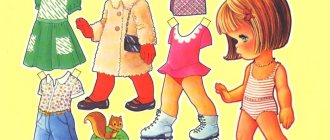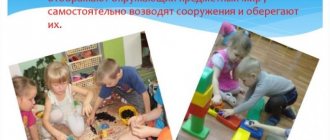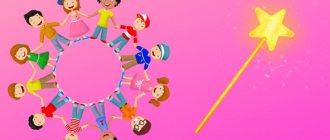Work: Master class “Atelier” Didactic manual. Designed for children from 4 to 7 years old. Goal: make an educational game.
Goals and objectives: Know the profession of a hair stylist.
Learn to select material for a specific clothing model, taking into account the color and texture of the fabric. The game promotes the aesthetic and sensory development of the child. Description: The manual consists of cards with clothing patterns and a set of cards - inserts with fabrics of different colors and textures, from light fabrics to draperies and fur. Didactic manual Master class “Atelier” Designed for children from 4 to 7 years old. It consists of cards with clothing patterns and a set of cards - inserts with fabrics of different colors and textures, from light fabrics to drapery and fur. Children are advised to choose the material for this clothing model. In this case, it is necessary to take into account not only the color, but also the texture of the fabric.
Photo No. 1 Children are encouraged to look at some types of fabrics and talk about their production. Threads for cotton fabrics are made from cotton, linen from flax, wool from animal hair, silk from the cocoons of silkworms. The quality of the fabric depends on this: silk threads are thin, and the fabric is thin, airy, and wool threads are thick, so their fabric is dense and warm.
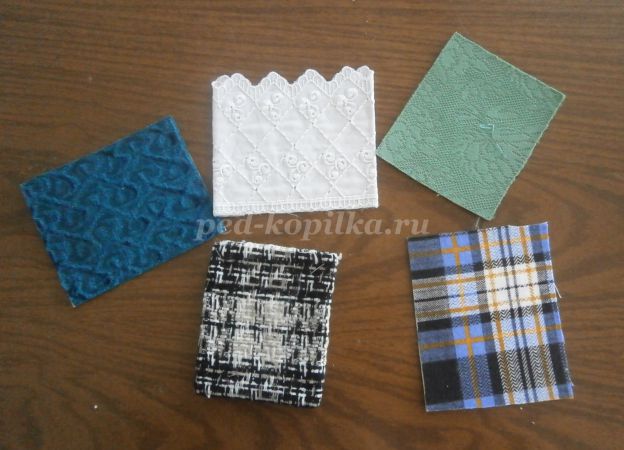
Photo No. 2 Fabrics are available in different colors.
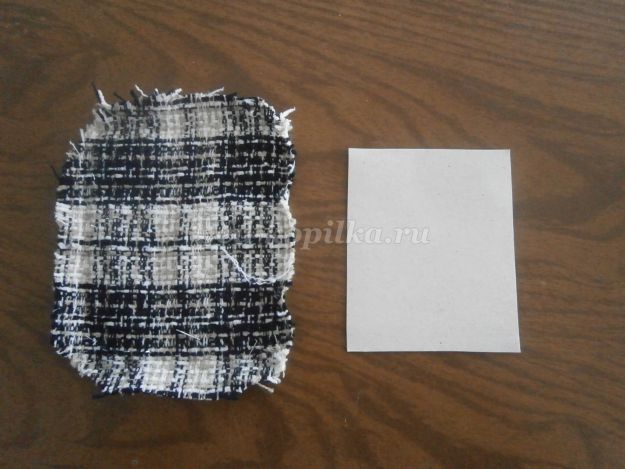
Photo No. 3 We take a material that is larger in size than cardboard.

Photo No. 4 Place the cardboard on the material.
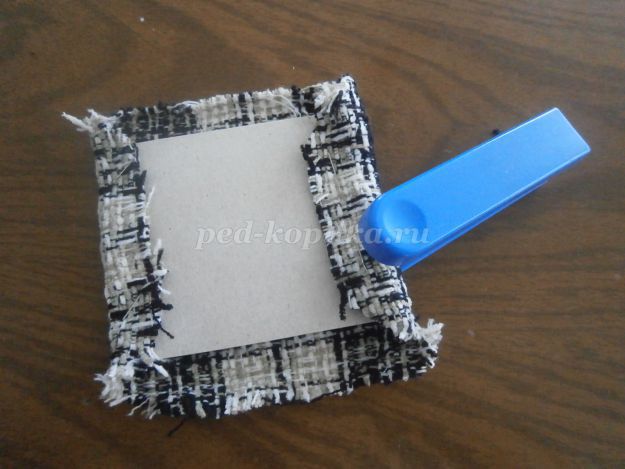
Photo No. 5 Using a stick or glue, we connect the cardboard with the material.

Photo #6 This is how we make removable business cards from different types of fabric.

Photo No. 7 Cut out the model you like from Fashion magazine, moving a little away from the outline.

Photo No. 8 Take a horizontal sheet, fold it in half and glue the cut out template onto one half.
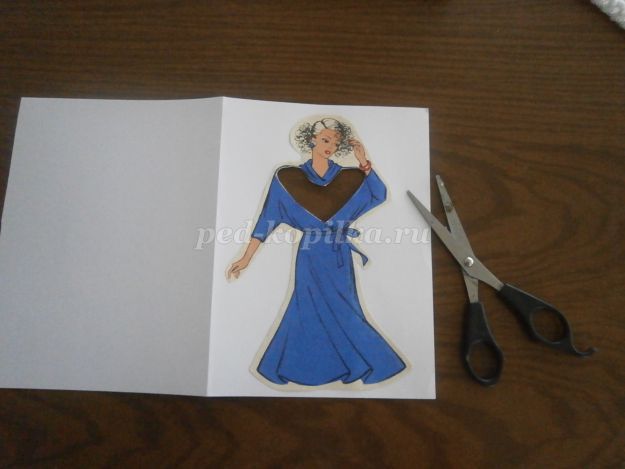
Photo No. 9 Then we cut out each detail on the model.
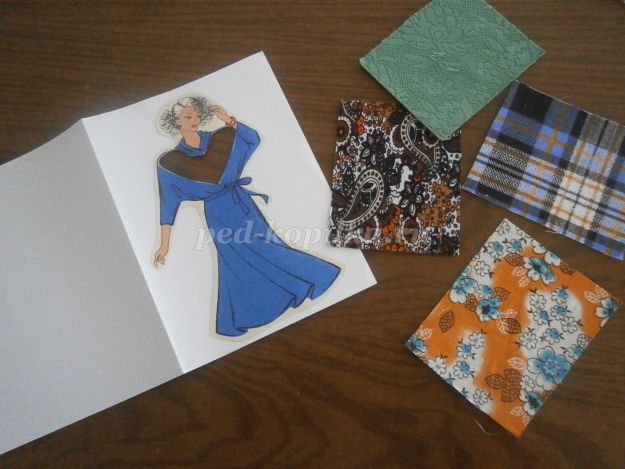
Photo No. 10 Now you can select the required material.
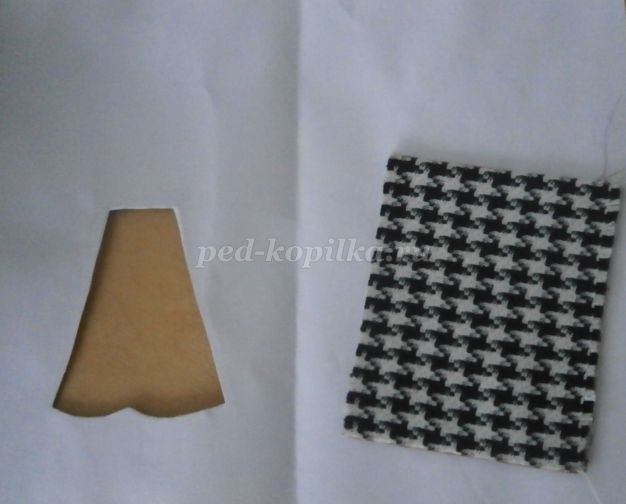
Photo No. 11 In the center of the album sheet we place cards with fabric, choosing those that are suitable in color and texture.
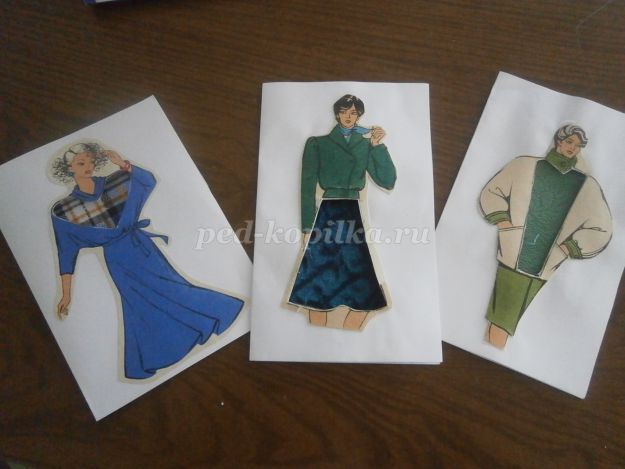
Photo No. 12 Thus, the game not only introduces the profession of a stylist-designer, but also contributes to the aesthetic and sensory development of the child. I hope this guide helps you organize your Atelier roleplaying game. Thank you for your attention.
What else to read: “Find the right object” - educational game
We recommend watching:
Didactic game for the younger group in kindergarten Didactic game for children from 6 to 9 years old. Fun vegetable garden Educational game in mathematics for preschoolers Didactic manual for the development of sensory abilities of children 4-6 years old
Similar articles:
Educational game for children 5-7 years old “The world around us”
Educational game for children 4-7 years old “Fairy Hotel”
Game model for children 4-7 years old “My City”
Atelier Corner
Ekaterina Egorova
Atelier Corner
For the screen you will need:
- 3 pieces of large plywood and 3 pieces of small
- satin ribbons of different widths,
- screws for fastening,
We connect large pieces of plywood with loops. The result was a screen. Then we paint with gouache (to prevent the gouache from cracking, mix it with PVA glue, after drying, cover with water-based varnish.
Then we glue pieces of fabric, ribbons and fabric with buttons sewn onto small pieces of plywood.
I attached all this to the outer parts of the screen, and in the middle I made a pocket for photographs with fashionable clothes (I cut it out of fashion magazines and glued it to cardboard)
.
I also made a hanger rack from leftover plywood and a wooden stick. I twisted clothes hangers from wire. I also made a clothing mannequin from a wooden stick and an empty bottle of dishwashing detergent. Then I covered it with napkins.
"Magic corner of fairy tales." Theater corner in the first junior group Theater corner in the 1st junior group Educators: Pertseva Irina Pavlovna Vorontsova Elena Yuryevna The versatility of theatrical play. Photo report about the excursion to the sewing studio. The group “Shalunishki” went on an excursion to the Voskhod sewing studio. Atelier "Voskhod" serves the residents of our city and beyond. On the first.
Summary of joint educational activities on the topic “Clothing. Atelier" MBDOU No. 27 "Kindergarten of a combined type" Kemerovo, Kemerovo region. Summary of joint educational activities.
Summary of the lesson “Journey to the Atelier” Purpose: to consolidate children’s knowledge about the professions of a seamstress, cutter, fashion designer, about buttons and their purpose. Objectives: • expand and specify. “Atelier “Masteritsa”. Game corner for a role-playing game on the topic “Profession - seamstress” as part of the competition “World of Professions” Teachers: Furshtakova Svetlana Anatolyevna, Kutueva Nailya Mazitovna. In preparation for the city competition - Kindergarten of the Year on the topic:. Subject-spatial developmental environment in the preschool educational institution “Experimentation Corner. Duty Corner" Experimentation Corner To solve problems of experimental activities in kindergarten, an appropriate organization is required.
Story game “Atelier” Goals: development and enrichment of the game’s plots. Teach children to take on a role in accordance with the plot of the atelier game. Objectives: 1. Expand the area.
Role-playing game "Atelier" Role-playing game "Atelier" Purpose of the game:. Developing the ability to apply knowledge about measurement methods in the game. Fostering respect for the work of a seamstress. Corner of solitude for the middle group “Paradise” An important condition for developing a child’s ability to manage his emotions is the organization of an appropriate environment. Effective form.
Source
For boys
However, there must be a place for boys to play in the play area. A children's corner for a boy may take up a little more space than for a girl. The main requirements for its location also remain convenience and accessibility for children. Such corners are created to take into account the gaming interests of children of different sexes, their differentiation and the development of gaming activities in general.
Design options are chosen based on the interests of the majority of boys in the group and general “boy” themes. For example:
- car showroom,
- nautical theme (ship),
- workshop,
- military base,
- or a corner of space in kindergarten.
Outer space will be interesting and useful for children of senior preschool age. With its help, children will gain basic knowledge about space, planets, and spaceships in a playful way.
The color scheme of such a corner is determined by the theme.
- blue,
- purple,
- white and yellow colors.
It would be good if the furniture for the corner was made in the same colors. If the group’s budget does not allow you to buy new furniture, you can use self-adhesive film of the desired color and texture. On the floor you can place a rug with a space theme (lunar surface, meteorite). A simple model of the solar system must be present - either as a poster on the wall, or paper planets in volumetric form, hanging from the ceiling.
Color solution
The locker room or reception area is the first thing a child and his parents see when they bring their child to kindergarten. Therefore, its design must be taken seriously. For children, there is usually a mood corner in kindergarten. The purpose of such a corner is to create a favorable emotional environment in the group. Thanks to it, children learn to understand not only their own mood, but also the mood of their peers.
In the design of such a corner, ready-made stands or home-made models can be used. The principle of their design is the same: in several pockets there are pictures with different emotions (their number depends on the age of the children), pockets for photographs of children are attached to the bottom. Coming to the group, the child, together with a parent or teacher, determines his mood and places his photo in the pocket under the corresponding emotion.
If the mood changes during the day, the photo is rearranged. Emotions can be depicted in the form of emoticons and cartoon characters. An approximate list in the older group could be: joy, fun, calm, surprise, sadness, anger.
Master class on making screens “Atelier”
Ekaterina Saenko
Master class on making screens “Atelier”
I bring to your attention a master class on making an “Atelier” screen for a role-playing game.
To make a screen we will need:
* Detergent bottle;
* Yogurt jar;
* Shoe box;
To design a screen for a role-playing game:
* Braid (wide, narrow, etc.);
* Various materials for didactic games;
This is the screen I made
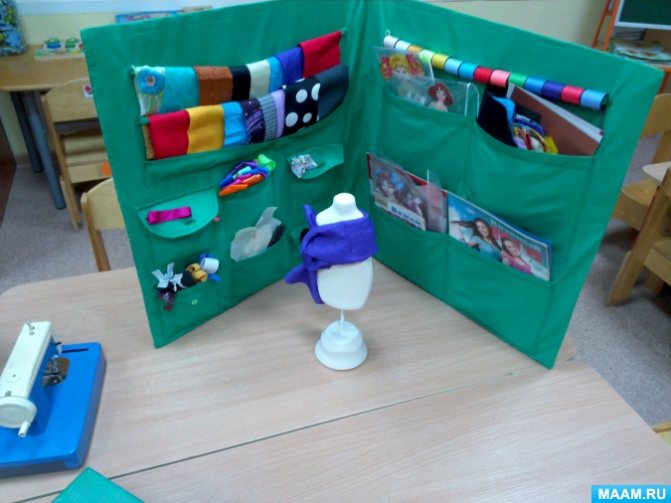
Let's start production
To begin with, from thick cardboard, which serves as the frame of my screen, we cut out two halves of the required size and glue them together.
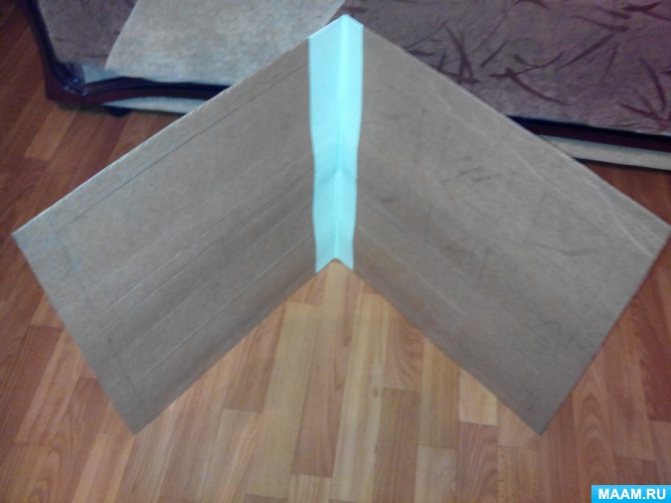
Next, we cut out the cover for our future screen, adding 1.5-2 cm to the seams.
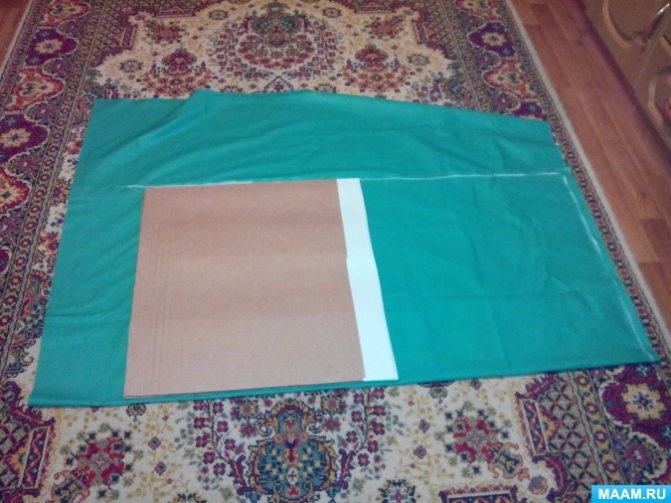
We cut out pockets and flaps into pockets of the sizes I need.
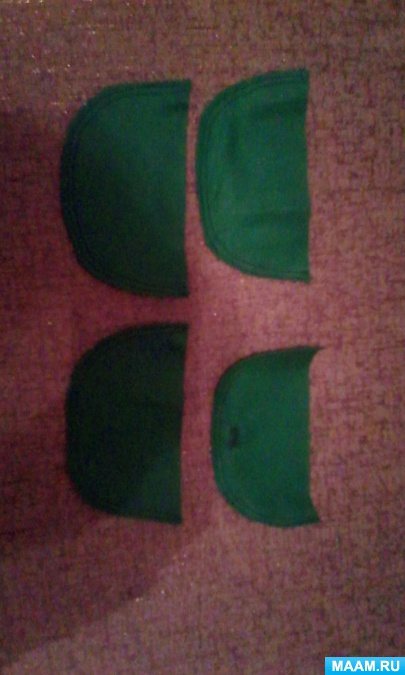
We baste them and sew them on the machine.
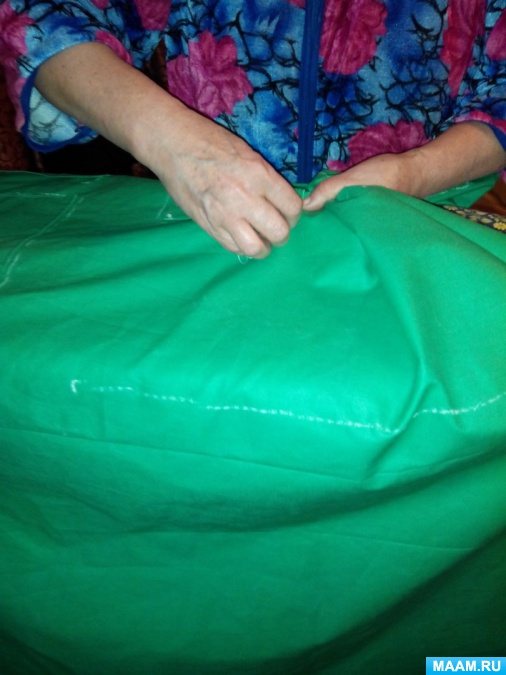
We cut out a 2 cm strip and insert sushi chopsticks into it. This bar will hold the demonstration material. In parallel with this, we are preparing a didactic game “Fashion Designer”
Where to begin?
Before you start decorating a group in a kindergarten and creating various thematic corners in a kindergarten, you should definitely take care of the general decoration inside the group. When painting, you should not use a lot of bright colors. It is better if the tone of the main paint is light and “warm”:
- beige,
- peach,
- pearl and so on.
Photo wallpapers with characters from fairy tales and cartoons, as well as stickers with children's themes, look good in children's groups.
It is better to decorate all the group’s rooms in the same style and think in advance about a theme that will tie together the bedroom, reception area, study area and play corners in the kindergarten. Before you start designing specific corners, you should consult with your parents, discuss together and get acquainted with possible options for children of different ages. Here are some corners that can be organized in a kindergarten; for an example, see the photo.
Developmental environment
Play space
Traditionally, each group has a separate room for a bedroom, and the common group room is divided into an activity area and a play area. Play corners for kindergarten are designed differently depending on the age of the children in the group, free space and the creative scope of the organizer. For example, in the play area, a separate place is often allocated for a mummering corner in a kindergarten.
The location for it must be chosen with special care, it must be easily accessible and constantly open to children. The purpose of its design is to create conditions in the group for the creative activity of children, the development of imagination, the formation of gaming skills, the implementation of gaming plans, and the cultivation of friendly relationships between children. You can decorate such a place in the form of a model house, a stylist’s office, or a small screen with a variety of outfits:
- professions,
- animals,
- artists,
- fairy tale heroes and so on.
Once the location has been determined and the design option has been selected, you can begin the practical part. The boundaries of the corner are formed using furniture. This could be: a low rack with shelves, drawers and a crossbar for clothes hangers. For convenience, a table and chairs can be located in the corner. A mandatory attribute in the mummers' corner should be a mirror where children can examine and evaluate their appearance. You can paste pictures of various suits, hats and other items of clothing on the wall.
Design options
Sometimes a hairdresser’s corner in a kindergarten fits harmoniously into such a corner. Here everything is ready to equip the hairdresser’s workplace - a table, a chair for the client, a mirror. On the table you can put bottles, combs, hair decorations, etc. You can glue pictures of scissors and combs on the wall. The apron for the master can be located on one of the hangers on the crossbar.
If space allows, the hairdressing salon corner in the kindergarten is designed separately, as an independent area for the role-playing game “Barbershop”. First, the necessary furniture and shelves are also installed. Instead of a rack with outfits, you can place a bedside table or mini-wardrobe with hairdressing supplies. You can also sew wall pockets for them. Then game items are added. Usually such a place is made as a children's corner for a girl, based on an interest in hairstyles, jewelry, and so on.
Mini-corner "Atelier".
Albina Bezrukova
Mini-corner "Atelier".
I bring to your attention a mini-corner “ Atelier ”.
Where you can order tailoring of a beautiful evening dress, skirt, sweater for a holiday and more. Our studio also presents various types of fabrics: silk, cotton, tulle, and many other types of fabric. Fabric comes not only in different types, but of course in different colors, which are presented in our mini-corner .
Girls model the style of a dress or skirt themselves. Choose the type and color of the fabric of the future dress. Of course, they don’t know how to sew yet; teachers and parents . It turns out very beautiful and original clothes.
Also in our mini-corner there is a dressing room , where quite a lot of things for dolls have already been sewn.
And beautiful evening dresses, and elegant blouses, and fur coats, and even a tracksuit.
All this was done with our own hands and from waste material.
Children enjoy playing in the mini-corner .
Synopsis of the plot-role-playing game "Atelier" Synopsis of the plot-role-playing game "Atelier" in the senior group. Goal: 1. enriching the social gaming experience between children, developing gaming skills.
Synopsis of the plot-role-playing game "Atelier" Synopsis of the plot-role-playing game "Atelier". Objective: To expand and consolidate children’s knowledge in the sewing studio, to form an initial idea.
Master class on making an “Atelier” screen I bring to your attention a master class on making an “Atelier” screen for a role-playing game. To make a screen we will need: * Fabric.
Material for a conversation about professions (Atelier) A fashion designer is an inventor. Without this profession, the work of the studio is not possible. He brings creative ideas and plans to life and creates sketches.
Scenario of ecological entertainment “Spring Fashion Studio” Ecological entertainment “Spring Fashion Studio” Author-compiler: Olga Sergeevna Trubnikova, teacher of MBDOU d/s village. Faschevka Purpose of the competition:.

